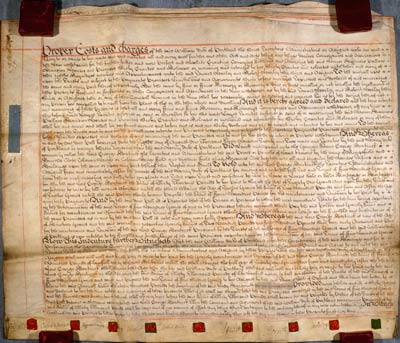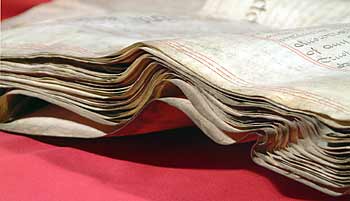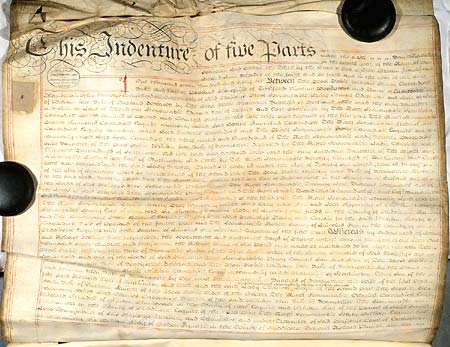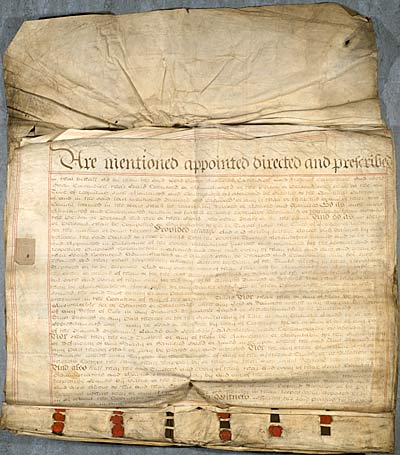More complex settlements
As heads of one of the major aristocratic families in Great Britain from the seventeenth to the twentieth centuries, the Dukes of Portland were no strangers to marriage settlements and entails. The Portland (London) collection is the archive of the family's London solicitors, and contains a vast amount of material relating to the management of their estates.
In this page, the provisions of some of the main settlements of the eighteenth century will be explained. Clink on the hyperlinks to see fuller descriptions of each document on the Manuscripts Online Catalogue.
Marriage settlement of the 2nd Duke of Portland (1734) (Pl F2/4/4)

View this deed
On 10 July 1734, the marriage settlement of William Bentinck, 2nd Duke of Portland was drawn up. William had succeeded to his father's estates in 1726. He was due to marry Lady Margaret Cavendish Harley, the only daughter of Edward Harley, Earl of Oxford and Mortimer.
The marriage settlement was made between five parties:
(1) William, Duke and Earl of Portland, Marquess of Tichfield, Viscount Cirencester and Baron of Woodstock.
(2) Edward, Earl of Oxford and Earl Mortimer; and Lady Margarett Cavendish Harley his only daughter.
(3) Edward Harley the younger of Eywood. Herefordshire, Esq.; and Robert Harley of Lincoln's Inn, Middlesex, Esq. (younger brother of Edward Harley).
(4) John, Earl Poulett, KG; and Henry, Viscount Morpeth.
(5) Henry, Earl of Uxbridge; and William, Lord Berkeley, Baron of Stratton, Cornwall.
The terms of the deed were as follows.
First, certain parts of the Duke of Portland's estates were earmarked for funding the terms of the settlement - pin money, jointures and portions payable to younger and female members of the family. This was done by the Duke of Portland (party 1) conveying all of his estates to his trustees Edward and Robert Harley (party 3) upon the following conditions:
- His estates in Bulstrode and Buckinghamshire were to be held by the Harley trustees to the use of the Earl of Oxford for a term of 80 years (or until the death of either the Duke of Portland or Lady Margaret). This was to secure £500 per year to Lady Margaret for her separate use as pin money during her married life. However, the rents of the estate were to be received by the Duke of Portland - in other words, the estates were only to be held by the Harleys in order to make sure that the £500 per year was paid, and for no other purpose
- All of the Duke of Portland's other estates, and the Bulstrode and Buckinghamshire estates subject to the foregoing term of years, were to be held to the use of the Duke of Portland for life
- Other parts of the estate were appointed to other trustees:
- An estate in Soho to Earl Poulett and Viscount Morpeth (party 4), for a term of 100 years, to secure a rentcharge of £1,600 to Lady Margaret as her jointure, payable if she was widowed. Any rents over and above this £1,600 were to be paid to the tenant for life
- An estate in Cumberland to the Earl of Uxbridge and Lord Berkeley (party 5), for a term of 600 years. This estate was to fund £20,000 as portions for the younger children of the marriage. Each younger child would get an equal part of this £20,000 when they turned 21, or when they married.
Then, the settlement laid out who should inherit the Duke of Portland's estate after his death:
- After the Duke's death, the estate would go to the use of his first son by Lady Margaret, and the heirs male of the son's body
- There was a remainder to the younger sons of the marriage successively, and the heirs male of their bodies [that is, if the eldest son died without any male heirs, the second son would inherit, and then the second son's eldest son, and so on]
- The ultimate remainder was to the Duke, his heirs and assigns. In other words, other heirs such as daughters could inherit if there were no male heirs
Some other clauses clarified the situation with regard to the Soho estate:
- The Duke of Portland had power to make provision of up to £800 per year for the jointure of any future wife out of the Soho estate
- The tenant for life, currently the 2nd Duke of Portland, was allowed to make leases of properties on the Soho estate for up to 70 years in duration
- It was recited that in 1722 the Soho estate had been appointed by the 1st Duke of Portland, under the powers of his marriage settlement, to his younger son Lord George Bentinck. The appointment was for 500 years from the death of the Duke (which happened in 1726), and was upon trust to raise £30,000. This trust was still in existence, and because the Soho estate was involved, could have got in the way of raising enough money for Lady Margaret's jointure
- Therefore, the Duke of Portland covenanted [agreed] with the Earl of Oxford to pay the sums due to his brother Lord George for his education and maintenance, and to pay £30,000 to Lord George when he reached the age of 21, out of other estates. The term of 500 years was to be assigned to the Earl of Oxford as further security for the payment of Lady Margaret's jointure
Finally, there was a consideration for all this. The Harley family agreed to secure £20,000 as Lady Margaret's marriage portion. This was achieved on the same date by another deed. In this deed Earl Poulett, at the direction of the Earl and Countess of Oxford, demised [leased] to the Duke of Portland certain properties in Northumberland for a term of 1,000 years, as the security for the payment of the £20,000.
Related deeds:
Because some parts of the Duke's estates had previously been settled, their entails had to be broken before they could be conveyed to the Harley trustees. The process had begun a month earlier, with a lease and release to make a tenant to the praecipe of the Duke's estates in Buckinghamshire, Hertfordshire, Middlesex and Hampshire (Pl F2/4/1). The week before the marriage settlement, on 3 July 1734, common recoveries of the Buckinghamshire and Middlesex estates were suffered (Pl F2/4/2 and Pl F2/4/3). These estates were now fee simple, so they could be conveyed to trustees with no legal problems.
What happened next?
In the 1734 marriage settlement, an estate in Cumberland was assigned to the Earl of Uxbridge and Lord Berkeley for a term of 600 years. This estate was to fund £20,000 as portions for the younger children of the 2nd Duke of Portland's marriage to Lady Margaret Cavendish Harley. Each younger child was to get an equal part of this £20,000.
In 1759 the 2nd Duke's eldest daughter Elizabeth married Thomas, Viscount Weymouth. How did Elizabeth benefit from her parent's marriage settlement, and what happened to her part of the £20,000?
Her marriage settlement (Pl F4/3/2) included the following clauses:
- Viscount Weymouth's estate was conveyed to trustees and charged with £3,000 for Elizabeth's jointure, payable in the event of her becoming widowed
- The estate was to be held by Viscount Weymouth for life and then to pass in tail male to the eldest son of the marriage
- Terms of years were created to secure the payment of £600 pin money to Elizabeth, and to raise portions for the younger children of the marriage
- £5000 was paid directly by the 2nd Duke to Viscount Weymouth as part of Elizabeth's marriage portion. A further £30,000 marriage portion for Elizabeth was assigned to trustees
Where had her marriage portion come from? It was stated in the marriage settlement that £6,666 13s 4d was Elizabeth's part of the £20,000 raised for younger children's portions under the marriage settlement of the 2nd Duke. The remaining £23,333 6s 8d was raised out of the estate of the Countess of Oxford and Mortimer - Elizabeth's grandmother - who by her will had bequeathed to each of the younger children of the Duke and Duchess of Portland such a sum as would make their portions up to £30,000.
Therefore, the portion which was earmarked in 1734 for future unborn children, was actually raised and paid out twenty five years later.
Marriage settlement of the 3rd Duke of Portland (1766) (Pl F5/1/5)


View this deed
Thirty two years after his father's marriage settlement, William Henry Cavendish, 3rd Duke of Portland, married Lady Dorothy Cavendish, sister of the Duke of Devonshire. His financial affairs were not in a particularly healthy state. A number of his estates were mortgaged, and his mother, the Dowager Duchess of Portland, was still alive and claiming her £1,600 per year jointure.
His marriage settlement, dated 5-6 November 1766, is in the form of a lease and release, and is very long and complicated. The release part is made up of 43 large membranes of parchment sewn together! The settlement was made between five parties:
(1) William Henry Cavendish, Duke and Earl of Portland
(2) The uncles and guardians of Lady Dorothy Cavendish.
(3) William, Duke of Devonshire (brother of Lady Dorothy); William, Earl of Bessborough; Thomas, Viscount Weymouth; and Lord Edward Charles Cavendish Bentinck.
(4) Horatio, Lord Walpole; George Harry, Lord Grey (son of Harry, Earl of Stamford); Sir Anthony Thomas Abdy of Lincoln's Inn Fields, Middlesex, Baronet; and Hon. John Bentinck, Esq., Captain in the Royal Navy.
(5) Hon. Robert Harley of Lincoln's Inn, Middlesex, Esq.; and John Heaton of Lincoln's Inn, Middlesex, gentleman.
The terms of the deed were as follows:
First, the Duke of Portland's estates were earmarked for funding the terms of the settlement - pin money, jointures and portions. This was done by the Duke of Portland (party 1) conveying all his estates by lease and release to his trustees Robert Harley and John Heaton (party 5).
- The estates were to be held to the use of Lady Dorothy's uncles and guardians (party 2), for a term of 200 years, to secure an annual rentcharge of £600 payable as pin money to Dorothy during the joint lives of her, the 3rd Duke of Portland and the Duchess Dowager (the Duke of Portland's mother). The sum would increase to £800 per year after the death or remarriage of the Dowager. It would increase to a £2,600 jointure if both Dorothy and the Dowager survived the 3rd Duke; and it would increase to £3,000 if Dorothy survived both the Dowager and the 3rd Duke. In the event, the Dowager died in 1785, and Dorothy in 1794, before the Duke - therefore, Dorothy should have received £600 per year until 1785, and £800 per year from 1785 to 1794
- In addition, the estates were to be held to the use of the Duke of Devonshire, the Earl of Bessborough, Viscount Weymouth and Lord Edward Charles Cavendish Bentinck (party 3), for a term of 600 years to secure portions of £20,000 for a single younger child of the marriage and a total of £30,000 for two or more younger children. In the event, there were four younger children, all of whom survived the 3rd Duke, and so would have shared £30,000 between them
- Furthermore, the estates were to be held to the use of Lord Walpole, Lord Grey, Sir Anthony Thomas Abdy and the Hon. John Bentinck (party 4), for a term of 1,200 years to secure portions of £20,000 or £30,000 as above, should there be daughters but no son surviving to adulthood. In the event, this trust was never executed because the two younger sons did survive to adulthood.
It was recited that the estates were already subject to an annual rentcharge of £1,600 secured to the Duchess Dowager [mother of the 3rd Duke of Portland], and to a provision for raising £20,000 in portions. Both of these things were part of the 1734 marriage settlement of the 2nd Duke of Portland.
It was extremely unusual for members of the aristocracy to have to charge every part of their estates with these kind of payments. It would normally have been sufficient to charge the jointure on estates in a given county, but the Duke of Portland was already too financially stretched.

View this deed
Then, the settlement laid out who should inherit the Duke of Portland's estate after his death:
- The Duke himself was the tenant for life
- After the Duke's death, the estate would pass to his first son by Lady Dorothy, and the heirs male of the son's body
- If the first son and his male heirs died, the estate would pass to the second son and his male heirs, and so on
- If there was no male issue of the marriage with Dorothy, the estate would pass to the male issue of the Duke of Portland by any subsequent wife, and their male issue
- If the Duke of Portland had no surviving sons, the estate would pass to his brother Lord Edward Bentinck for life, and then to Lord Edward's male issue successively
- The ultimate remainder was to the Duke of Portland's general heirs [including daughters]
Some further clauses set out what would happen in certain circumstances:
- The Duke of Portland was given power to make provision of up to £1,000 per year for a second wife, and £10,000 in portions for any children by such second wife [There was in fact no second wife]
- Lord Edward Bentinck was given power, if he become tenant for life, to make provision of up to £2,000 per year for his wife and £20,000 in portions for any issue [Lord Edward Bentinck did not, in the event, inherit]
- The Duke was given power to grant leases for three lives on the Hampshire estate, and for 99 years on the Soho estate
- The Duke was given power, if he came into possession of certain estates governed by the Countess of Oxford's will (estates which would pass down from his mother the Dowager Duchess of Portland), to charge those estates with the portions and jointures above, on the same trusts as above. This was in place of charging them on the 'paternal' Cavendish-Bentinck estates which were already too financially stretched. This illustrates how vulnerable the Duke of Portland's estates were while his mother was alive, and how much he hoped the estates inherited from her would form part of the family's financial recovery.
The consideration was £30,000. This was Lady Dorothy's marriage portion from her parents. This money was badly needed by the Duke of Portland; so much so that it was stated in the marriage settlement that £10,000 of it would immediately be paid to Portland's trustees (party 5) to enable them to pay off a mortgage on the Soho estate.
Related deeds:
On the same date as the marriage settlement, another deed was executed: an assignment of terms of years in trust to attend the uses of the settlement (Pl F5/1/7). In this deed, Edmund Pepys of Southampton Street in the parish of St George Bloomsbury, Middlesex (the executor of John Lucas, deceased), assigned to Sir Anthony Thomas and John Heaton a term of 500 years in the Soho estate which had been created in 1722, and terms of 500 and 1,000 years in premises specified in Fulmer, Buckinghamshire, created in 1722 and 1756 respectively. The trustees of the 3rd Duke of Portland's marriage settlement were now responsible for all of the terms of years relating to these particular estates.
One week later, the Duke and Duchess of Portland executed a release and quitclaim (essentially, an acknowledgment of receipt) of £6,000. This money had been provided for the Duchess as one of the younger children of the 4th Duke of Devonshire, under the terms of her parents' marriage settlement (Pl F5/1/41).
Resettlement of the estate in 1776-1777
As noted above, the marriage settlement of the 3rd Duke of Portland was based around the hope that once he inherited his mother's estates, he could move his liabilities from his 'paternal' estates to the 'maternal' estates, enabling the sale or mortgage of more of his land.
In fact, the Dowager Duchess of Portland agreed to some changes in her lifetime.
In 1771, she agreed to give up her life interest in the Harley 'maternal' estates in return for a fixed payment of £16,622 a year (Pl F5/7/1).
On 12 December 1776 her jointure of £1,600 per year, which was charged on the 'paternal' Soho estate, was moved to the 'maternal' estates (Pl F5/1/8).
Six weeks later, more deeds were drawn up. A revocation of uses by the Duke of Portland (Pl F5/1/10), dated 31 January and 1 February 1777, cancelled the terms of the 1766 marriage settlement in respect of his 'paternal' estates in Cumberland, Buckinghamshire and Soho. The estates were conveyed by him to trustees, upon trust to sell or mortgage the lands and to apply the proceeds in repayment of his debts. This revocation and conveyance could not be done by the Duke alone. The people who had been parties to the 1766 marriage settlement, or their representatives, had to agree. Therefore, Lord Edward Charles Cavendish Bentinck (one of the trustees in the 1766 settlement appointed to secure the payment of portions to younger children) was one of the parties to the revocation of uses, as was John Heaton, a trustee to preserve contingent remainders.
In 1782 the Duke of Portland used a private Act of Parliament to create a trust for sale of some of the 'maternal' estates in Derbyshire and Northumberland (Pl F5/7/25).
All of these transactions eventually allowed the sale of the Cumberland, Soho, most of the Buckinghamshire estates, and some of the Northumberland estates of the Duke of Portland in the late eighteenth and early nineteenth centuries. Other estates were mortgaged.
The process of freeing land for sale was a very complicated one. This was necessary, because settlements and entails had been designed to keep estates together, not to allow them to be sold!
Next page: Associated documents